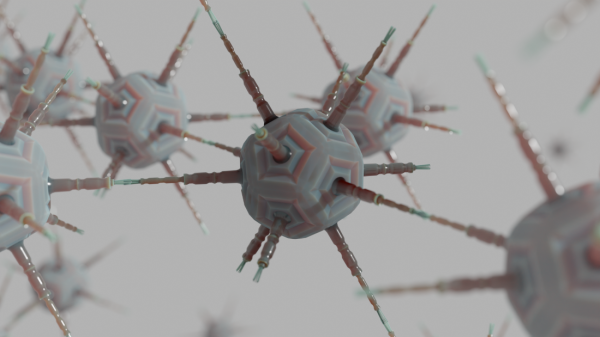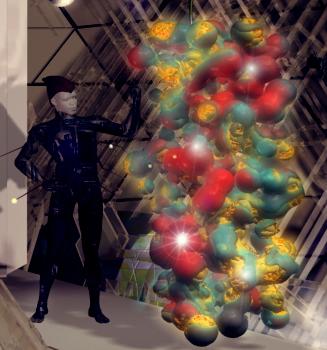BY LETTER
Utility Fog
Technology > Technology Type or Material > Drytech/Hylotech
Technology > Application > Envirotech
Technology > Technology Levels > High Tech / Hitech
Technology > Application > Envirotech
Technology > Technology Levels > High Tech / Hitech
Reconfigurable swarm material capable of replicating a wide range of physical structures and environments | |
 Image from Tasp | |
| Utility fog consists on a very large number of extremely small foglets, devices which can link together and form structures. The foglets are also capable of absorbing and transmitting light and sound in order to reproduce a wide range of phenomena. | |
Crude forms of Utility Fog were available in enclosed environments during the Interplanetary Age, but fully functional fog was not widely available until the Early Federation Age.
In use, Utility fog can consume considerable power for computation and reconfiguration, and produce considerable waste heat; for this reason the fog must be used in the most efficient way possible for any particular purpose. This requires sophisticated control systems, which are generally distributed throughout the fog itself. Phased array projectors are often incorporated into the fog, often on or near the surface layers, allowing it to display a range of images and to replicate a range of environments. Using optical phased arrays, utility fog can even become apparently transparent or invisible.
Depending on local environment, number of users, and various other factors, ufog may operate in either a 'lie-in-wait' or 'pervasive' mode. In lie-in-wait mode, foglets are primarily stored in a layer along the floor, walls, and ceiling of whatever space they are servicing, extending from the surrounding surfaces to form objects, manipulators, and virtuality interfaces and overlays as required. In pervasive mode, a three-dimensional array of foglets fills the volume and provides a total immersion environment for those operating with it. As pervasive ufog is opaque users of these environments must take advantage of augmented reality senses. Alternatively ufog immediately around users may flatten into holographic screens that project false images. Both modes make use of discrete reservoirs in walls, floors, and ceilings to provide additional foglets as required.
In normal operation, utility fog is organized in a dynamically controlled manner designed to optimize operational efficiency while minimizing reaction time and issues of waste heat production and removal. This means that the fog will seamlessly (and invisibly) transition from lie-in-wait mode to pervasive mode and vice-versa as circumstances or the local environment require.
Colloquially, utility fog is often known as u-fog or ufog, and variants thereof, in various Anglic dialects.
Related technologies include utility liquid, a denser form of utility fog suspended in liquid (usually water, which can absorb greater amounts of heat than other fluids), utility sand which uses larger robot units comparable in size to a sand grain, and modubots and blockbots which use even larger scale units, all of which can replicate some or most of the qualities of utility fog.
Common uses of utility fog, beyond creating facsimiles of physical items and environments, include providing easier locomotion in microgravity environments. Thin (ankle-deep) layers of utility fog can replace gravity as a method of keeping people oriented in a common fashion, establishing a false sense of up and down, though sensations of microgravity will persist of not suppressed through other means. In addition utility fog can be used within a zero gravity environment to prevent objects and users from drifting and tumbling.
Utility Fog civilizations, with intelligent individuals who exist as distributed entities within the fog, have evolved a number of times, but rarely last more than a few centuries before transcending. One of the very few stable ones is Nimbus.
 Image from Juan Ochoa | |
| A sentient entity made of Utility Fog from Nimbus meets a nearbaseline human | |
Related Articles
- Active Materials
- Active Polymorphic Defence
- Airwall
- Angelnet Fog - Text by John B
One side effect of angelnets making use of pervasive utility fog (or other space filling smart matter) in a terran-standard atmosphere has come to be called 'Angelnet Fog'. Effectively, each microbot in the three dimensional mesh acts as the seed for a raindrop, with water coalescing out of the atmosphere onto its surface. This tends (in poorly regulated angelnets) to lead to high degrees of mist and fog at ground level. It can be an interesting phenomenon to fly into a heavily angelnetted city from above the angelnetting, seeing large, odd-shaped 'columns' of fog, only later to realize that what you're seeing is the angelnet fog surrounding various buildings. - Distributed Intelligence
- Effector Frame
- Eidolon
- Fog Swarm Projection - Text by M. Alan Kazlev
A rl projection of physical objects and entities through the behavior of trillions of foglets. Fog swarms can be seamlessly merged with virch environments to create a continuum from totally virtual to totally rl. - Foglet
- Hyperfog
- Nimbus
- Plasm
- Utility Sand
- Wer-weave
Appears in Topics
Development Notes
Text by M. Alan Kazlev, after the concept by J. Storrs Hall, in Anders Sandberg's Transhuman Terminology
Additional material by Steve Bowers 2024
Initially published on 15 December 2001.
<{{https://en.wikipedia.org/wiki/Utility_fog,https://en.wikipedia.org/wiki/Utility_fog}}>
Additional material by Steve Bowers 2024
Initially published on 15 December 2001.
Article about Utility Fog from io9
How utility fogs could become the technology that changes the world Utility Fog at Wikipedia<{{https://en.wikipedia.org/wiki/Utility_fog,https://en.wikipedia.org/wiki/Utility_fog}}>







